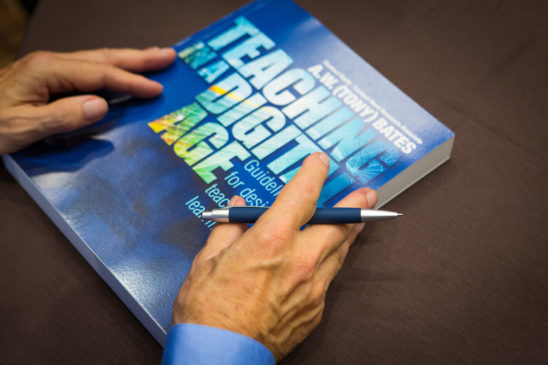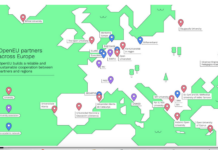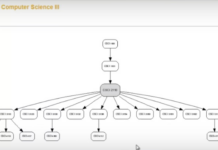
I’ve now decided to start on a third edition of ‘Teaching in a Digital Age.’ I began work on the first edition in 2014 and completed in 2015. The second edition was started four years ago (2018) and was completed it in 2019. I’d like to get the third edition completed by April 2022. I’d appreciate your help and feedback to ensure the third edition fully meets the needs of teachers and instructors.
Why change?
There are several reasons for doing a third edition now, rather than wait another year, as I originally intended.
- The main one is to ensure that the book reflects the lessons learned from Covid-19, and the resulting developments in digital learning.
- Although the book was originally intended primarily for a post-secondary audience, the book is also heavily used in teacher education. I want to ensure that there is as much explicit focus on k-12 as on post-secondary education in the book.
- Technology continues to develop and change. Although I would prefer to wait another year so that new technologies not covered in the 2019 edition have had time to go through the Gartner hype cycle, Covid-19 in particular raises the issue of the impact of video technologies such as Zoom. I also want to discuss the increasing importance of commercial technology offerings and tools such as LinkedIn Learning and Google Classroom on the design of teaching and learning and its organisation.
Feedback on the first two editions
Since the book was first published, there have been many reviews of the book. I recently discovered 23 reviews of the book in BCcampus’ Open Textbook Library. There is also an extensive review by the American journal, Teacher Education for MERLOT II. Of these 24 book reviews, sixteen gave a five star rating (the highest), seven a four star rating, and one a three star rating. More importantly, there was valuable feedback in each of these reviews which I will take note of when making revisions for the third edition. If you know of other reviews, particularly in academic journals, please direct me to them.
Integration, separation or a new book?
Given the events and developments over the last three years, I have several choices.
- Integrate changes within the current second edition, while keeping the existing length of the book
- Have two versions of the book: one focused on post-secondary education, and another (almost certainly with other appropriate co-authors) focused on k-12 education
- A new book entirely, focused on the impact of Covid-19 on post-secondary and k-12 education.
- Do nothing. The book seems to work for most – why not just leave it?
I am veering towards integration. On re-reading the book in the light of Covid-19 and thinking how it applies to k-12 as well as post-secondary education, the book seems to me to be still remarkably relevant, but it needs to make sure the lessons from emergency remote learning and k-12 issues are addressed. This means tweaking rather than radical change – or do you not agree?
What changes?
Needless to say, I don’t intend to mess with the structure of the book, which has proved to be enormously successful. I am conscious that it is already, with appendices, more than 600 printed pages. I don’t want to make it any longer. I am hoping mainly to replace examples, provide alternative activities, and perhaps replace some text with more recent findings. In other words I’m going to try to integrate the changes rather than to add extra material, while widening the focus to encompass more openly k-12 education.
I am also conscious that the first edition of the book has been translated into nine languages, and volunteers are currently working on translating the second edition. In the second edition, the changes are in a different text colour to the original to speed up translation and to enable instructors who used the first edition to identify quickly the changes made to each section in the second edition. I will do the same for the third edition. This should not hold up current translations of the second edition as they are still likely to be valid for the third edition.
Here are some of the changes I am considering:
- The impact of Covid-19. I will replace some of Chapter 1, Section 4 on Change and Continuity to include one or two paragraphs on the general impact of Covid-19 on college and school teaching. I will briefly discuss the impact of technology access (or lack of it) particularly for school children in Chapter 1, Section 6.3. I will widen the discussion of digital natives to include other factors such as ethnicity, gender and age. In Chapter 1, Section 1.7 I will update the data on online enrolments in post-secondary education and include a section on the impact of Covid-19 on on-campus courses post-Covid-19, and participation of school-age children in online learning before, during and after Covid-19. I will reduce or remove entirely Chapter 1, Section 1.7.4 on MOOCs as this is dealt with more fully in Chapter 5. I may also update and shorten Chapter 5.
- I will go through each section of the book to ensure that there are examples and text about k-12 teaching where this differs from post-secondary education. I will add two or three k-12 based scenarios, and I will add some podcasts focused on k-12 education (probably with guest contributors from the k-12 sector). Similarly I will review the activities to ensure that k-12 teaching is covered. I would particularly appreciate external help from specialists in k-12 digital teaching in making such changes. In particular I would welcome suggestions about other teaching methods appropriate for k-12 not covered in Chapters 3 and 4, especially those that relate to digital learning (e.g. Seymour Papert’s work?).
- The main changes regarding technology will be mainly in Chapter 7.6, where there needs to be discussion of Zoom and other video technologies, where they fit in the analysis, and implications for teaching with such technologies. There will also need to be a paragraph added to 8.4 on the affordances of video streaming. I don’t intend to add to the emerging technologies of simulations/games, augmented/virtual reality and AI that I added to Chapter 8 for the second edition, but if you have any other new major technology that you feel deserves to be added please let me know.
Over to you
And this is where I need your help. Reader feedback, on the drafts of the first edition which I first published in this blog, was particularly helpful. If I have not suggested changes above that you think should be included in the revision (or there are parts of the existing text that you think should be removed), please let me know by email to tony.bates@ubc.ca.
I will also post drafts of the changes on this blog, with a commentary on why I am making these changes.
Overall though the book has stood well the shock of Covid-19, but recent developments need to be accounted for in the book. Above all, the value of online, open textbooks becomes obvious, because it is much easier to update and keep relevant than a printed version.









 Dr. Tony Bates is the author of eleven books in the field of online learning and distance education. He has provided consulting services specializing in training in the planning and management of online learning and distance education, working with over 40 organizations in 25 countries. Tony is a Research Associate with Contact North | Contact Nord, Ontario’s Distance Education & Training Network.
Dr. Tony Bates is the author of eleven books in the field of online learning and distance education. He has provided consulting services specializing in training in the planning and management of online learning and distance education, working with over 40 organizations in 25 countries. Tony is a Research Associate with Contact North | Contact Nord, Ontario’s Distance Education & Training Network.


Thanx for ‘Teaching in a Digital Age’ which I use in many of my courses.
I am wary of taking too much from covid19 at this stage. At the time there were many claims that sars would revolutionise education, but 5 years after: what is sars? As devastating as it was, the 1918 flu pandemic had remarkably little medium let alone long term effect on higher education.
Hi Tony, thanks for your work, I am using your book in my courses. My advice is to write about social annotation in higher education, referring to Perusall as well.
http://www.ckbg.org/qwerty/index.php/qwerty/article/viewFile/365/307
Thanks, Graziano – will definitely follow up: it looks an interesting publication.
Hi Tony, I am an instructional designer at a regional college, where we have both high school and post secondary classes. My preference, like your own, is for a book that incorporates K-12 and post secondary.
Hi Tony,
Thanks for your work on “Teaching in a Digital Age.” I was introduced to it when I took my Masters of Educational Technology and Design back in 2018. I spent this past school year working with a new online school for our school division in response to Covid and found it to be a challenging… and rewarding experience as we tackled how best to help students learn remotely. Having your expertise in addressing this area will be vital.
I think an area that should be covered in your revisions is the use of interactive apps like Kahoot, Edpuzzle, FlipGrid, Jamboards, and other collaborative apps that allow students to interact with the content and how that relates to overall retention.
Having a K-12 focus in light of Covid-19 will help all teachers become better digital instructors.
Thanks, Chris. I will follow up on interactive apps, as well as the use of some newer social media apps that are being used by students. Your comments are really welcome
best regards